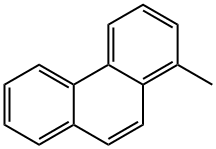Uses
1-Methylphenanthrene is a polycyclic aromatic hydrocarbon that has been found in particulate matter from small-scale biomass combustion from old and modern technologies and that has caused acute systemic and lung inflammation in mice after intratracheal aspiration.
Definition
ChEBI: A member of the class of phenanthrenes that is phenanthrene substituted by a methyl group at position 1.
Synthesis Reference(s)
The Journal of Organic Chemistry, 45, p. 2009, 1980
DOI: 10.1021/jo01298a054Tetrahedron Letters, 6, p. 359, 1965
General Description
White crystalline powder.
Air & Water Reactions
Insoluble in water.
Reactivity Profile
Vigorous reactions, sometimes amounting to explosions, can result from the contact between aromatic hydrocarbons, such as 1-METHYLPHENANTHRENE, and strong oxidizing agents. They can react exothermically with bases and with diazo compounds. Substitution at the benzene nucleus occurs by halogenation (acid catalyst), nitration, sulfonation, and the Friedel-Crafts reaction. 1-METHYLPHENANTHRENE is sensitive to excessive heat and light.
Fire Hazard
Flash point data for 1-METHYLPHENANTHRENE are not available. 1-METHYLPHENANTHRENE is probably combustible.
Source
Detected in 8 diesel fuels at concentrations ranging from 0.10 to 210 mg/L with a mean
value of 44.33 mg/L (Westerholm and Li, 1994). Identified in a South Louisiana crude oil at a
concentration of 111 ppm (Pancirov and Brown, 1975). Schauer et al. (1999) reported 1-
methylphenanthrene in diesel fuel at a concentration of 28 μg/g and in a diesel-powered mediumduty
truck exhaust at an emission rate of 17.0 μg/km.
California Phase II reformulated gasoline contained 1-methylphenathrene at a concentration of
3.91 g/kg. Gas-phase tailpipe emission rates from gasoline-powered automobiles with and without
catalytic converters were approximately 1.63 and 122 μg/km, respectively (Schauer et al., 2002).
Schauer et al. (2001) measured organic compound emission rates for volatile organic
compounds, gas-phase semi-volatile organic compounds, and particle-phase organic compounds
from the residential (fireplace) combustion of pine, oak, and eucalyptus. The respective gas-phase
and particle-phase emission rates of 1-methylphenanthrene were 2.22 and 0.579 mg/kg of pine
burned and 1.04 and 0.050 mg/kg of oak burned. The gas-phase emission rate was 0.720 mg/kg of
eucalyptus burned.
